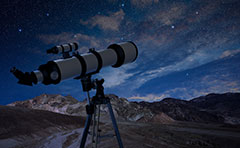 Master Bond has played an important role in the assembly of advanced telescopes used in astronomical research. From refracting telescopes to reflecting telescopes to radio telescopes to X-ray and gamma ray telescopes our compounds have contributed to many visual observations and influential discoveries by examining stars, galaxies, planets, comets. Through the utilization of Master Bond adhesive, sealant, coating systems lenses, curved mirrors, mounds, clock drives, telecompressors and control interfaces have been precisely mated/aligned to assure superior image quality. They have also enabled astronomers to gather and analyze data to further our understanding of the universe, its evolution and gain valuable insight into physics/chemistry.
Master Bond has played an important role in the assembly of advanced telescopes used in astronomical research. From refracting telescopes to reflecting telescopes to radio telescopes to X-ray and gamma ray telescopes our compounds have contributed to many visual observations and influential discoveries by examining stars, galaxies, planets, comets. Through the utilization of Master Bond adhesive, sealant, coating systems lenses, curved mirrors, mounds, clock drives, telecompressors and control interfaces have been precisely mated/aligned to assure superior image quality. They have also enabled astronomers to gather and analyze data to further our understanding of the universe, its evolution and gain valuable insight into physics/chemistry.
Ground, space and flying (airplane, balloon) telescopes have been developed in a variety of sizes, shapes and are employed to obtain different objectives. The chief advantage of space based telescopes is that they produce clearer images than ground based telescopes. In contrast, space based telescopes can be subjected to maintenance issues, cost constraints, obsolescence and launch failure. Since spacecraft and satellites are exposed to a much more severe environment than land based telescopes it is critical that adhesives displayed in space meet the most rigorous requirements. This includes resistance to high temperatures, cryogenic conditions, intense radiation, high vacuum, thermal cycling while retaining precise control over outgassing. Release of any contaminants can lead to clouding optical electro-optical systems preventing mission critical systems from functioning properly. Job proven NASA low outgassing Master Bond epoxies, silicones have overcome these demanding constraints and have been customized to specific customer mechanical, electrical and physical needs.
